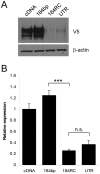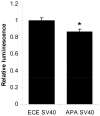Endothelin-converting enzyme-1 (ECE-1) is post-transcriptionally regulated by alternative polyadenylation
- PMID: 24497914
- PMCID: PMC3908869
- DOI: 10.1371/journal.pone.0083260
Endothelin-converting enzyme-1 (ECE-1) is post-transcriptionally regulated by alternative polyadenylation
Abstract
Endothelin-converting enzyme-1 (ECE-1) is the enzyme predominantly responsible for producing active endothelin-1 (ET-1), a mitogenic peptide implicated in the aetiology of a number of diseases, including cancer. Elevated levels of ECE-1 have been observed in a range of malignancies, with high expression conferring poor prognosis and aiding the acquisition of androgen independence in prostate cancer. The mechanisms regulating the expression of ECE-1 in cancer cells are poorly understood, hampering the development of novel therapies targeting the endothelin axis. Here we provide evidence that the expression of ECE-1 is markedly inhibited by its 3'UTR, and that alternative polyadenylation (APA) results in the production of ECE-1 transcripts with truncated 3'UTRs which promote elevated protein expression. Abolition of the ECE-1 APA sites reduced protein expression from a reporter vector in prostate cancer cells, suggesting these sites are functional. This is the first study to identify ECE-1 as a target for APA, a regulatory mechanism aberrantly activated in cancer cells, and provides novel information about the mechanisms leading to ECE-1 overexpression in malignant cells.
Conflict of interest statement
Figures






References
-
- Battistini B, Chailler P, D'Orleans-Juste P, Briere N, Sirois P (1993) Growth regulatory properties of endothelins. Peptides 14: 385–399. - PubMed
-
- Bagnato A, Catt KJ (1998) Endothelins as autocrine regulators of tumor cell growth. Trends Endocrinol Metab 9: 378–383. - PubMed
-
- Knowles J, Loizidou M, Taylor I (2005) Endothelin-1 and angiogenesis in cancer. Curr Vasc Pharmacol 3: 309–314. - PubMed
-
- Rosanò L, Spinella F, Bagnato A (2013) Endothelin 1 in cancer: biological implications and therapeutic opportunities. Nat Rev Cancer 13: 637–651. - PubMed
-
- Valdenaire O, Lepailleur-Enouf D, Egidy G, Thouard A, Barret A, et al. (1999) A fourth isoform of endothelin-converting enzyme (ECE-1) is generated from an additional promoter molecular cloning and characterization. Eur J Biochem 264: 341–349. - PubMed
Publication types
MeSH terms
Substances
LinkOut - more resources
Full Text Sources
Other Literature Sources

